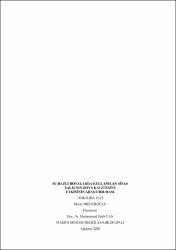Su bazlı boyalarda kullanılan Sivas talkının boya kalitesine etkisinin araştırılması
Özet
Talk boya endüstrisinde yaygın olarak kullanılan fonksiyonel bir dolgu hammaddesidir. Ülkemizde zengin talk yatakları bulunmasına rağmen boya endüstrisinin talep ettiği özelliklere sahip uygun morfolojide, örtücülük değeri yüksek mikronize talk üretilememektedir. Bu yüzden boya endüstrisi kaliteli talk ihtiyacını karşılayabilmek için çoğu zaman ithal ürünler tercih etmektedir. Talkın boyadaki performansı, tane morfolojisi, boyut dağılımı, yağ emmesi gibi yapısal özelliklere bağlıdır. Ülkemizin en önemli talk yatağı olan Sivas (Zara) bölgesi talkı kimyasal ve mineralojik açıdan kaliteli olmasına rağmen, öğütme işlemi sonrasında elde edilen ürünlerin ithal talk ürünlerine göre istenilen özelliklerde olmadığı görülmüştür.
Sivas talkının boya uygulamalarında görülen zafiyetleri; talkın morfolojik, fiziksel ve yüzey özellikleri bir fonksiyonel dolgu olarak boya kalitesi (örtücülük, vs.) parametreleri üzerinden tartışmaya açılmış ve iyileştirilmesine dönük deneysel çalışmalar yapılarak özellikle talkın morfolojisini etkileyen farklı öğütme şartlarında elde edilen numuneler ile 3 adet ticari talkın boyadaki performansları kıyaslanmıştır.
Birinci aşamada tüvenan talk, farklı öğütme mekanizmasına sahip, geleneksel bilyeli değirmen ve karıştırmalı bilyeli değirmen kullanılarak öğütülmüş ve her bir değirmen için en düşük ortalama tane boyutu (d50) dikkate alınarak öğütme şartları belirlenmiştir. Burada üretilen talk numuneleri ve ticari talk numuneleri ile piyasada geçerliliği olan bir su bazlı boya reçetesi kullanılarak boya üretimi yapılmıştır. Her bir reçetede ticari talk miktarı ile aynı oranda (%5) öğütülmüş talk kullanılmıştır. Talk dolgulu üretilen her bir boyanın örtme gücü tayini yapılmıştır.
Öğütme ile elde edilen talk numuneleri boya deneyi sonuçları dikkate alınarak karakterize edilmiş (tane boyutu, yağ emme, vs.) ve neticesinde tane boyutu-örtücülük ilişkisini sorgulamak amacıyla seçilen numunelerin yüzey özellikleri (temas açısı, zeta potansiyeli, yüzey enerjisi, vs.) belirlenmiştir. Ayrıca, öğütülmüş talk numunelerinin SEM görüntüleri ve AFM analizleri yorumlanarak tane morfolojisinde (uzun kenar/kısa kenar oranı, yuvarlaklık, vs.) meydana gelen değişimler tespit edilmiştir.
Nihayetinde, öğütme sonrası morfolojisi değişen talk tanelerinin yüzey özelliklerinin de değiştiği ve buna bağlı olarak boya süspansiyonu içerisinde farklı dağılım ve çökme davranışları sergiledikleri deneylerle ortaya konmuştur. Bu davranış süspansiyon içerisinde taneler üzerinde etkin olan itme ve çekim kuvvetleri ile klasik DLVO teorisine göre incelenmiş özellikle itme (EDL) kuvvetlerinin baskın olarak boya içerisindeki talkın davranışını belirlediği tespit edilmiştir.
Yine yapılan AFM analizlerinde talkın karakteristik özelliği olan yanal ve düzlem yüzeylerde öğütme sonrası meydana gelen değişimler ile talk tanelerinin süspansiyon içerisindeki davranışlarının da değiştiği (Kynch) çökme teorisi yardımıyla izah edilmiştir. Talc is a functional filler commonly used in paint industry. Although having reach talc deposits in our country a final micronized talc product required by paint industry with the specification of fine particle size and more important with high opacity cannot be produced. Therefore, imported talc products are preferred to supply the high quality talc demand of domestic paint industry. The performance of talc in paint depends on its structural properties like particle morphology, particle size distribution, oil absorption. In spite of having chemically and mineralogical high quality of talc raw material in Sivas – Zara, reach and important talc deposits of Turkey, it is seen that ground talc products from this region are not in accordance with the required properties compared to import talc products.
The weakness of Sivas talc in paint applications were opened to discussion through the morphological, physical and surface properties of talc as a functional filler in terms of the paint quality (opacity, etc.) and was tried to be improved with experimental studies. The performances of talc products produced at different grinding conditions effecting its morphology were compared with the performances of imported three merchant talc samples in paint.
In the first step, talc raw material was ground and grinding parameters were determined by considering the lowest aver. Particle size (d50) for each conventional ball mill and agitated ball mill. Paint production was realized according to an industrial water-based paint receipe by using merchant talc samples and the talc samples produced at grinding experiments. The amount of talc in each receipe kept constant (5%) and opacity was measured for each paint produced by talc samples.
Talc samples obtained from grinding were characterized (particle size, oil absorption, etc.) by considering paint results and surface properties like contact angle, zeta potential, surface energy, etc. have been determined on selected samples to question the relationship between particle size and opacity. Also, the differences at particle morphology (aspect ratio, roundness, etc.) were determined by using SEM images and AFM analysis of ground talc samples.
Finally, it was shown with the experiments that the dispersion and settling behaviours of talc particles in paint suspension differed due to change at their surface properties depending on the change at their morphology after grinding. This behaviour was evaluated according to classical DLVO theory with the attractive and repulsive forces effective on particles in suspension and was determined that specially the attractive forces (EDL) were dominant on talc behaviour in paint.
It was also seen on AFM analysis that the characteristics plane and edge surfaces of talc were changed due to grinding and the behaviour of talc in suspension was also changed depending on this change. This was explained by the help of (Kynch) settling theory.
Bağlantı
https://hdl.handle.net/11630/8541Koleksiyonlar
- Doktora Tezleri [57]



















